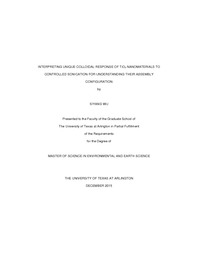
ATTENTION: The works hosted here are being migrated to a new repository that will consolidate resources, improve discoverability, and better show UTA's research impact on the global community. We will update authors as the migration progresses. Please see MavMatrix for more information.
Show simple item record
| dc.contributor.advisor | Choi, Hyeok | |
| dc.creator | Wu, Siyang | |
| dc.date.accessioned | 2016-01-27T22:11:05Z | |
| dc.date.available | 2016-01-27T22:11:05Z | |
| dc.date.created | 2015-12 | |
| dc.date.issued | 2015-11-24 | |
| dc.date.submitted | December 2015 | |
| dc.identifier.uri | http://hdl.handle.net/10106/25511 | |
| dc.description.abstract | It is important to determine the assembly configuration of engineered nanomaterials (ENMs) particularly between aggregate or agglomerate because the assembly configuration greatly influences their fate and transport behavior in the aquatic environment. Aggregated particles are more subject to segregation upon changes of environmental conditions (vice versa) than agglomerated particles. As a strategic tool for investigating the time-resolved reversible segregating and assembling behavior of ENMs and thus estimating their assembly configuration, controlled sonication process was proposed. It was hypothesized the unique colloidal response of ENMs to sonication, with respect to changes in size, might be their intrinsic property associated with assembly configuration. As a model ENM, three different TiO₂ particles with unique properties (two commercial P-25 and UV 100 and one home-made (HM) TiO₂) were tested with a programmed sonication process (sonication followed by quiescence, different sonication intensities) under various environmental settings (TiO₂ concentration and pH). When they were dispersed in water, all TiO₂ tested obviously assembled to form much larger particles. Size of P-25 decreased immediately upon sonication and did not change significantly under subsequent quiescence step while sizes of UV 100 and HM gradually decreased and then slowly recovered back to their initial sizes. The trend was generally observed in all conditions tested. The unique colloidal response of TiO₂ particles could be explained by their properties associated with assembly configuration. P-25 was concluded to be in aggregate configuration and thus can be practically called nanoparticles while UV 100 and HM were in agglomerate configuration. | |
| dc.format.mimetype | application/pdf | |
| dc.language.iso | en_US | |
| dc.subject | Titanium dioxide | |
| dc.subject | Particle assembly | |
| dc.subject | Aggregation | |
| dc.subject | Agglomeration | |
| dc.subject | Sonication | |
| dc.subject | Segregation | |
| dc.subject | Fate and transport | |
| dc.title | Interpreting unique colloidal response of TiO2 nanomaterials to controlled sonication for understanding their assembly configuration | |
| dc.type | Thesis | |
| dc.date.updated | 2016-01-27T22:13:12Z | |
| thesis.degree.department | Earth and Environmental Sciences | |
| thesis.degree.grantor | The University of Texas at Arlington | |
| thesis.degree.level | Masters | |
| thesis.degree.name | Master of Science in Earth and Environmental Science | |
| dc.type.material | text | |
Files in this item
- Name:
- WU-THESIS-2015.pdf
- Size:
- 896.9Kb
- Format:
- PDF
This item appears in the following Collection(s)
Show simple item record


